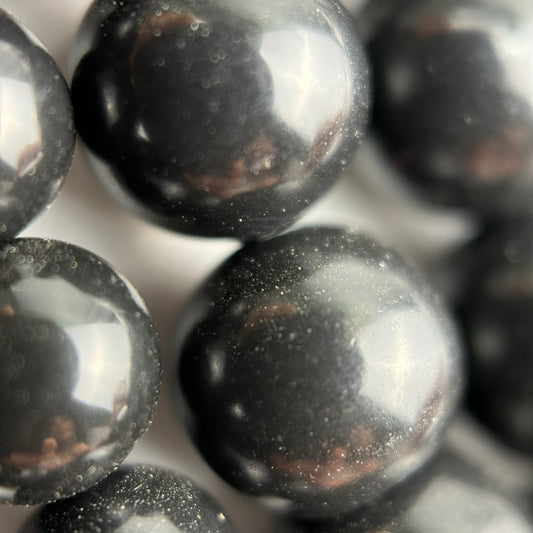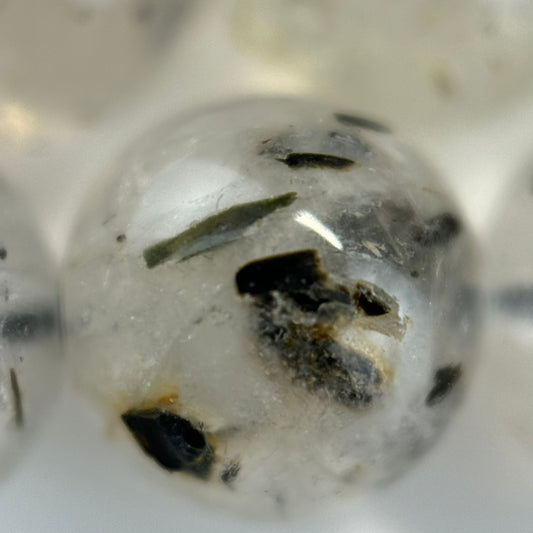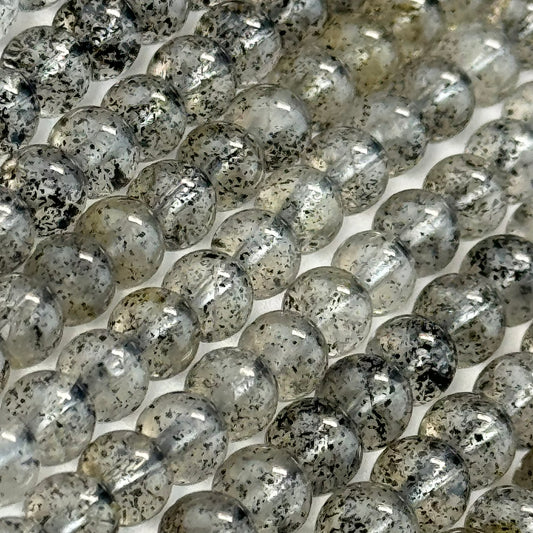Mica Gemstone Beads
Exploring Mica Gemstone Beads
Mica is a group of sheet silicate minerals known for their perfect basal cleavage and distinctive pearly to vitreous luster. These minerals form in thin, flexible sheets that create unique visual effects when used in jewelry applications.
Distinctive Characteristics
- Perfect basal cleavage into thin sheets
- Pearly to vitreous luster
- Flexible and elastic sheets
- Mohs hardness of 2-4
- Various colors depending on type
Mineralogical Composition and Types
Mica encompasses several related minerals including muscovite (white mica), biotite (black mica), phlogopite (brown mica), and lepidolite (lithium mica). Each type has distinct properties.
Common Mica Varieties
- Muscovite: Colorless to pale colors
- Biotite: Dark brown to black
- Phlogopite: Brown to yellow-brown
- Lepidolite: Pink to purple
- All share sheet silicate structure
Crystal Structure and Cleavage
Mica's most distinctive property is its perfect basal cleavage, allowing it to split into extremely thin, flexible sheets. This structure creates its characteristic appearance.
Structural Properties
- Sheet silicate structure
- Perfect basal cleavage
- Thin, flexible sheets
- Elastic properties
- Layered crystal structure
Formation and Geological Occurrence
Mica forms in various geological environments including igneous, metamorphic, and sedimentary rocks. It's a common mineral in many rock types.
Formation Environments
- Igneous rocks: Granites and pegmatites
- Metamorphic rocks: Schists and gneisses
- Sedimentary rocks: As detrital grains
- Hydrothermal veins
- Contact metamorphism zones
Color Variations and Appearance
Mica displays various colors depending on its chemical composition. The pearly luster and sheet structure create distinctive visual effects.
Color Characteristics
- Muscovite: Colorless to pale
- Biotite: Dark brown to black
- Phlogopite: Brown to yellow
- Lepidolite: Pink to purple
- Pearly luster common
Cutting and Processing Challenges
Mica's perfect cleavage and softness present challenges for cutting and processing. Special techniques are required to create beads.
Processing Considerations
- Perfect cleavage requires care
- Softness limits durability
- Special cutting techniques needed
- Stabilization may be required
- Protective treatments common
Hardness and Durability Considerations
With a Mohs hardness of 2-4, mica is quite soft and requires careful handling. It's not ideal for everyday jewelry wear without protection.
Durability Factors
- Mohs hardness: 2-4 (very soft)
- Susceptible to scratching
- Perfect cleavage increases breakage risk
- Requires protective settings
- Not suitable for active wear
Geographic Sources and Mining
Mica occurs worldwide in many locations. Major sources include India, Brazil, Russia, and the United States.
Primary Sources
- India: Major producer of sheet mica
- Brazil: Various mica types
- Russia: Significant deposits
- United States: Various locations
- China: Commercial production
Care and Maintenance Guidelines
Mica requires very gentle care due to its softness and perfect cleavage. Proper handling prevents damage.
Care Instructions
- Handle with extreme care
- Clean gently with soft cloth
- Avoid water exposure
- Store in protective containers
- Protect from impacts
- Consider stabilization treatments
Jewelry Design Applications
Mica beads create unique jewelry pieces, though their softness limits applications. They're often used in collector pieces or stabilized forms.
Design Uses
- Collector jewelry pieces
- Stabilized mica applications
- Decorative elements
- Special occasion jewelry
- Display pieces
Industrial and Commercial Uses
Beyond jewelry, mica has numerous industrial applications due to its unique properties, including electrical insulation and cosmetics.
Commercial Applications
- Electrical insulation
- Cosmetic applications
- Paint and coatings
- Plastics and rubber
- Construction materials
Metaphysical Properties and Symbolism
Mica holds significance in various metaphysical traditions, associated with clarity, reflection, and protection.
Symbolic Meanings
- Clarity and reflection
- Protection properties
- Light amplification
- Spiritual insight
- Energy balancing
Comparison with Similar Materials
Mica may be confused with other sheet minerals or materials. Understanding its specific properties aids in identification.
Distinguishing Features
- Perfect basal cleavage unique
- Flexible and elastic sheets
- Pearly luster characteristic
- Softness distinguishes from harder minerals
- Sheet structure distinctive
Frequently Asked Questions
What is the mineralogical classification and chemical composition of Mica?
Mica refers to a group of phyllosilicate minerals with a layered structure. The most common varieties used in jewelry include Muscovite (KAl2(AlSi3O10)(OH)2), Biotite (K(Fe,Mg)3(AlSi3O10)(OH)2), and Phlogopite (KMg3(AlSi3O10)(OH)2). All micas share a sheet-like crystal structure with perfect basal cleavage.
What is the unique property of Mica's perfect basal cleavage?
Mica exhibits perfect basal cleavage in one direction, meaning it can be split into extremely thin, flexible sheets. This property results from the weak bonds between the silicate layers in its crystal structure. While this creates beautiful thin sheets, it also makes mica beads more fragile and requires careful handling in jewelry applications.
What is the Mohs hardness and how does it affect Mica bead durability?
Mica has a Mohs hardness ranging from 2.5 to 4, depending on the variety (Muscovite ~2.5-3, Biotite ~2.5-3, Phlogopite ~2.5-3). This low hardness makes mica beads relatively soft and prone to scratching. They require protective settings or careful stringing to prevent damage from harder materials or impacts.
What causes the pearlescent or metallic luster in Mica beads?
The pearlescent luster in mica results from light interference between the thin, parallel layers of the crystal structure. When light reflects off these multiple layers, it creates iridescent colors and a silky, pearlescent appearance. The effect is most pronounced in thin sheets but can be visible in thicker beads when properly oriented.
What are the different varieties of Mica used in jewelry and their characteristics?
Muscovite (white/silver mica) is most common in jewelry, known for its transparency and silvery appearance. Biotite (black/brown mica) is darker and more opaque. Phlogopite (brown/amber mica) has a golden-brown color. Each variety has slightly different properties, but all share the characteristic sheet-like structure and perfect cleavage.
What is the specific gravity and how does it vary among Mica varieties?
Mica has a specific gravity ranging from 2.7 to 3.1, depending on the variety. Muscovite has SG ~2.76-2.88, Biotite ~2.7-3.1, and Phlogopite ~2.78-2.85. This relatively low density makes mica beads lightweight compared to many other gemstone materials, contributing to their appeal in larger jewelry pieces.
What are the primary geological sources and formation environments of Mica?
Mica forms in igneous, metamorphic, and sedimentary environments. Major sources include India (particularly for Muscovite), Brazil, Madagascar, Russia, and the United States. Mica typically forms in pegmatites, schists, and gneisses, where it crystallizes in large sheets or books. India is the world's largest producer of sheet mica.
How does Mica's sheet structure affect its use in bead making?
The sheet structure makes mica challenging to work with in bead form. The perfect cleavage means beads must be cut carefully to avoid splitting, and the material is typically stabilized or backed with other materials for durability. Some mica beads are actually thin mica sheets applied to other substrates rather than solid mica.
Can Mica beads be stabilized or treated for jewelry use?
Yes, mica beads are often stabilized with resins or backed with other materials to improve durability and prevent delamination. The thin sheets may be laminated or encapsulated to protect them from moisture and physical damage. Natural, untreated mica beads are more fragile and require extra care.
What causes the color variations in different Mica varieties?
Color variations result from different chemical compositions. Muscovite's aluminum content creates white/silver colors, Biotite's iron and magnesium create dark brown/black colors, and Phlogopite's magnesium creates golden-brown colors. Trace elements can also influence the exact shade and may create green, pink, or other tinted varieties.
How should Mica beads be cleaned and maintained?
Clean mica beads gently with a soft, dry cloth. Avoid water, chemicals, or any cleaning solutions that could penetrate between the layers and cause delamination. Never use ultrasonic or steam cleaning. Store separately in a soft pouch to prevent scratching, and avoid exposure to moisture or sudden temperature changes.
What makes Mica beads unique compared to other gemstone materials?
Mica is unique due to its perfect basal cleavage, allowing it to be split into extremely thin, flexible sheets. Its pearlescent luster, low density, and distinctive layered structure set it apart from other gemstones. The ability to create thin, iridescent sheets makes it valuable for both solid beads and decorative applications.
How does the flexibility of Mica affect its durability in jewelry?
While mica's flexibility allows it to bend without breaking, this same property makes it vulnerable to delamination and splitting along cleavage planes. In jewelry, mica beads require protective settings or stabilization to prevent the layers from separating. The flexibility is an advantage for thin sheets but a challenge for solid beads.
What optical properties contribute to Mica's visual appeal?
Mica's optical properties include its pearlescent luster, transparency to translucency (depending on variety), and sometimes asterism or chatoyancy when inclusions are present. The layered structure creates interference colors and a silky appearance that is highly valued in jewelry, especially when the material is properly oriented and polished.
What are the limitations of using Mica in jewelry applications?
Mica's low hardness (2.5-4), perfect cleavage, and sensitivity to moisture limit its use in jewelry. It's prone to scratching, splitting, and delamination. For these reasons, mica beads often require stabilization, protective settings, or are used in pieces that won't experience heavy wear. It's better suited for decorative or occasional-wear jewelry.





